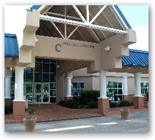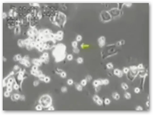The clinical trial is looking for contributions for this process. It is being called a “potential cure” but the results of the trial will further define that.  This process involves boosting the immune system, and there are several biotech drugs in development that work the same process. The trial is based on a study done at Wake Forest and we all know what they also do there, they grow human organs and several folks are walking around with bladders grown in petri dishes.
This process involves boosting the immune system, and there are several biotech drugs in development that work the same process. The trial is based on a study done at Wake Forest and we all know what they also do there, they grow human organs and several folks are walking around with bladders grown in petri dishes.
Scientists At Wake Forest Grow a Mini Liver From Human Cells–Regenerative Medicine
Urethras Grown at Wake Forest–6 Years Later Five Young Men Are Doing Fine
The institute has requested funds and grants from the NIH and they are also looking for private contributions to get the trial moving. By boosting the white cell immune system they were able to “cure” mice who had cancer. The FDA approved this process for human trials. Based upon seeing mice cured, this looks to be very promising. They are looking for donors as well and have not had a problem finding healthy people who can give blood.
The home page for the clinical trials can be found here. When a qualified patient is identified, granulocytes are collected from  “matched donors”. The institute also offers other cancer treatments to include leukemia, multiple myeloma and more. The patients participating in the trial will be those who have already tried conventional therapies and have not had a response. The trial page goes into detail as well about being a donor, the procedure and the two drugs administered during the process.
“matched donors”. The institute also offers other cancer treatments to include leukemia, multiple myeloma and more. The patients participating in the trial will be those who have already tried conventional therapies and have not had a response. The trial page goes into detail as well about being a donor, the procedure and the two drugs administered during the process.
This is the first ever approved trial using this study protocol to sold tumor cancers. The video below is very good on explaining how cancer comes back and the ultimate goal here is to stop the process by giving the body enough power in their own system to fight back. The process sounds like it would make sense and if it works, well this could be a cure. BD
From the website:
“Our clinical protocol is based on a 1999 study conducted at Wake Forest University by Dr. Zheng Cui. Dr. Cui discovered a cancer resistant mouse. No matter how Dr. Cui attempted to infect this mouse with cancer, he couldn’t do it, the mouse’s immune system was just too strong. Forty percent of this mouse’s descendants inherited the same significant cancer resistance. The white blood cells of these mice were able to seek out and destroy cancer cells not only in cell cultures, but also in living mice. Dr. Cui designed a test to measure this Cancer-Killing Activity, called CKA, and used those cells from cancer resistant mice to cure other mice with cancer. Further investigation showed that high levels of CKA granulocytes were also found in the white blood cells of some healthy people, specifically in the immune systems of young healthy humans around the age of eighteen to twenty-five.
inherited the same significant cancer resistance. The white blood cells of these mice were able to seek out and destroy cancer cells not only in cell cultures, but also in living mice. Dr. Cui designed a test to measure this Cancer-Killing Activity, called CKA, and used those cells from cancer resistant mice to cure other mice with cancer. Further investigation showed that high levels of CKA granulocytes were also found in the white blood cells of some healthy people, specifically in the immune systems of young healthy humans around the age of eighteen to twenty-five.
White cell infusion therapy essentially translates the basis of Dr. Cui’s discovery into humans.
Instead of using white cells from mice whose immune system prevented them from developing cancer, we’re using the white cells taken from the immune systems of twenty year olds. If you take a twenty year old and you look at the incidence of cancer versus a seventy year old, a seventy year old has a one-hundred times greater risk of cancer. That’s because the immune system of young healthy donors are so much stronger. In theory, this study treatment may have the ability to supercharge the immune system using carefully cross-matched cancer-killing granulocytes donated by healthy young donors.”
Press Release:
Boynton Beach, FL, June 8, 2012 - Chances are, you know someone who has been diagnosed with cancer. One out of every three women will contract the disease in their lifetime; for men the odds are even greater. Now, an exciting new protocol has received approval from the FDA and WIRB (Western Institutional Review Board) to conduct a Phase I/II clinical trial on humans for treatment of solid tumor (metastic) cancers using a treatment designed to “supercharge the patient’s immune system and “zap” the cancer cells, destroying them.”
Leading the investigation is Dr. Dipnarine Maharaj, Director of the South Florida Bone Marrow and Stem Cell Transplant Institute in Boynton Beach, Florida. A hematologist and oncologist, Dr. Maharaj has been successfully treating patients with blood cancers for years using stem cell treatments. The clinical trials now underway target solid tumor cancers such as breast, cervical, stomach, pancreatic, lung, and melanoma.
As Dr. Maharaj explains, “A characteristic of a metastic cancer cell is the way it divides into twins. One of the twins will actually begin to form  tissues while the other twin lies dormant. The standard therapy for treating metastatic tumors is chemotherapy. Chemotherapy will kill a certain number of tumor cells and those cells may shrink, so it will look as though you’re making progress, but with the immune system weak, the dormant twin can begin to form new tumors, which is why these cancers often return.
tissues while the other twin lies dormant. The standard therapy for treating metastatic tumors is chemotherapy. Chemotherapy will kill a certain number of tumor cells and those cells may shrink, so it will look as though you’re making progress, but with the immune system weak, the dormant twin can begin to form new tumors, which is why these cancers often return.
“Our protocol is based on a 1999 study conducted at Wake Forest University by my colleague, Dr. Zheng Cui. Dr. Cui discovered a cancer resistant mouse. No matter how many times Dr. Cui attempted to infect this mouse with cancer, he couldn’t do it; the mouse’s immune system was simply too strong. Further investigation showed that the mouse’s white cells possessed granulocytes – specialty cells that sought out cancer cells and eradicated them. These same granulocytes were also found in the white blood cells of humans, specifically in the immune systems of young, healthy people around the ages of nineteen through twenty-five. Our protocol is to treat metastic cancer patients with cancer killing granulocytes donated by young healthy cross-matched donors in order to repair or supercharge the patient’s immune system."
As promising as the new protocol sounds, there remains a funding hurdle to overcome. In recent years grant money from the National Institute of Health has been more difficult to obtain, and insurance companies do not pay for treatments during clinical trials.
To meet the financial challenge, the Institute has just launched a new website: www.ZapCancer.org which explains the protocol, provides vital answers for cancer patients, collects tax-deductible donations to fund the clinical trial, and contains a video presentation produced by N.Y. Times best-selling author, Steve Alten, whose father died from melanoma two weeks before he was to receive the protocol. Says Alten, “Cancer is a horrible disease that affects all of us. And yet, if a million people simply donated $10, the Institute could complete the first phases of this vitally important investigation, a necessary step to one day treating patients worldwide. For the simple cost of a movie ticket or paperback book, we could help fund a potential cure for solid tumor cancers. I pray that everyone will take a look at the ZapCancer.org website, make a small donation, and spread the link around.”



0 comments :
Post a Comment